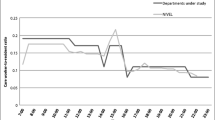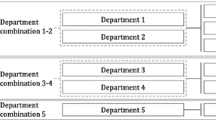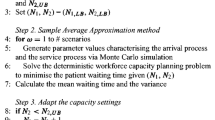Abstract
Adhering to pre-defined service routes that cover a fixed set of wards in a shift, the inpatient phlebotomy service provides 24-hour coverage for a 27-storey, 1,400-bed hospital. We present an application of mathematical optimization to improve its service efficiency without injecting additional resources. A mixed integer programming model was implemented to revamp the service route configuration to minimize workload discrepancies among service routes, limit maximum daily workload per route and restrict routes to span a maximum number of floor levels, while taking into consideration the ward-specific demand for each duty (i.e. daytime, evening, and night time) throughout the day. This data-driven and evidence-based approach has facilitated an overhaul of the existing route configuration of the inpatient phlebotomy service, which resulted in a more effective and contented workforce, as well as a more efficient service with an evened-out workload among phlebotomists and increased time spent on direct patient care by phlebotomists. Subsequent scenario analysis revealed that more manpower on a micro-level is not necessarily better and highlighted the importance to strategically design duty hours and allocate manpower across different duties on a system level.






Similar content being viewed by others
Notes
It has to be noted that although phlebotomists carry out the vast majority of the phlebotomy and ECG service, a small subset (e.g., blood culture and urgent blood sampling) has to be conducted by doctors and nurses. However, the service demand for non-phlebotomists is not within the scope of this study. In addition, specialized phlebotomy services for paediatrics and immunocompromised patients are also not covered by CPT and thus also not covered in this study.
References
Berg, JE, Ahee, P and Berg, JD. (2011). Variation in phlebotomy techniques in emergency medicine and the incidence of haemolysed samples. Annals of Clinical Biochemistry, 48(6), 562–565.
Burke EK, De Causmaecker P, Berghe GV, and van Landeghem H (2004) The state of the art of nurse rostering. Journal of Scheduling 7(6), 441–499.
Gunawan, A and Lau, HC. (2013). Master physician scheduling problem. Journal of the Operational Research Society, 64(3), 410–425.
Jeon BR, Seo M, WY Lee, Shin HB, Lee SH and Lee YK (2010) Improving the blood collection process using the active-phlebotomist phlebotomy system. Clinical Laboratory 57(1–2), 21–27.
Mannion, H and Nadder, T. (2006). Three alternative structural configurations for phlebotomy: a comparison of effectiveness. Clinical laboratory science: Journal of the American Society for Medical Technology, 20(4), 210–214.
Morrison AP, Tanasijevic MJ, Goonan EM, Lobo MM, Bates MM, Lipsitz SR, Bates DW and Melanson SEF (2010) Reduction in specimen labeling errors after implementation of a positive patient identification system in phlebotomy. American Journal of Clinical Pathology 133(6), 870–877
Morrison AP, Tanasijevic MJ, Torrence-Hill JN, Goonan EM, Gustafson ML and Melanson SEF (2011) A strategy for optimizing staffing to improve the timeliness of inpatient phlebotomy collections. Archives of Pathology & Laboratory Medicine 135(12), 1576–1580.
Rousseau, L-M, Pesant, G and Gendreau, M. (2002). A general approach to the physician rostering problem. Annals of Operations Research, 115(1–4), 193–205.
Wolsey LA (2008) Mixed integer programming. Wiley Encyclopedia of Computer Science and Engineering.
Author information
Authors and Affiliations
Corresponding author
Electronic supplementary material
Below is the link to the electronic supplementary material.
Rights and permissions
About this article
Cite this article
Yip, K.C.M., Huang, K.W.H., Ho, E.W.Y. et al. Optimized staff allocation for inpatient phlebotomy and electrocardiography services via mathematical modelling in an acute regional and teaching hospital. Health Syst 6, 102–111 (2017). https://doi.org/10.1057/s41306-016-0001-8
Received:
Revised:
Accepted:
Published:
Issue Date:
DOI: https://doi.org/10.1057/s41306-016-0001-8




